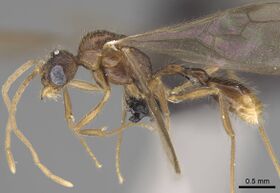Key to Vitsika males
This key to males is based on: Bolton, B. & Fisher, B.L. 2014. The Madagascan endemic myrmicine ants related to Eutetramorium (Hymenoptera: Formicidae): taxonomy of the genera Eutetramorium Emery, Malagidris nom. n., Myrmisaraka gen. n., Royidris gen. n., and Vitsika gen. n. Zootaxa 3791:1–99. doi:10.11646/zootaxa.3791.1.1
This key is based on known males, both described forms from known and validly named species plus additional forms that are currently unassociated with a known species.
You may also be interested in
1
- Propodeal dorsum, or the upper half of the propodeal declivity, or both, with a median, longitudinal carina . . . . . 2
- Propodeal dorsum and declivity without trace of a median longitudinal carina . . . . . 5
2
return to couplet #1
- Postpetiole in dorsal view very obviously longer than broad (W/L ca 0.80) . . . . . Vitsika labes
- Postpetiole in dorsal view broader than long (W/L > 1.00) . . . . . 3
3
return to couplet #2
- Propodeal median longitudinal carina is absent from the declivity; it is confined to the dorsum and terminates in a pair of obliquely laterally directed carinae at the junction of dorsum and declivity. In profile the propodeum armed with a very low, broadly triangular tooth; the apex of this tooth, in posterior view, is seen as the junction of 4–5 short carinae . . . . . male sp. A
- Propodeal median longitudinal carina is present on the upper half of the declivity, and may be present or absent along the dorsum. Propodeum unarmed, or at most with a low, rounded carina, without a broad triangular tooth and without a confluence of 4–5 carinae in posterior view . . . . . 4
4
return to couplet #3
- Median longitudinal carina absent from propodeal dorsum. Colour entirely yellow. Scape relatively long, SL 0.27 (SI ca 50); funiculus segment 9 ca 1.57 × SL . . . . . Vitsika crebra
- Median longitudinal carina present on propodeal dorsum. Colour entirely dark brown. Scape relatively short, SL 0.20 (SI ca 32); funiculus segment 9 ca 1.47 × SL . . . . . male sp. B
5
return to couplet #1
- Postpetiole in dorsal view longer than broad. Colour dull yellow with infuscated patches. Upper arc of eye surrounded by a broad, shallow trench . . . . . Vitsika breviscapa
- Postpetiole in dorsal view broader than long. Colour dark brown. Upper arc of eye not surrounded by a broad, shallow trench. . . . . . male sp. C
Diagnoses
Diagnoses of the males of breviscapa, crebra and labes are given under species discussions. Critical characterisations of the unassociated males are as follows.
Male sp. A: HL 0.71, HW 0.58, CI 82, SL 0.20, SI 34, mesoscutum maximum width 0.66, WL 1.16, EL 0.34, MfL 0.92. Propodeal dorsum with a broad, open rugoreticulum anteriorly, near the metanotum. Propodeum with a median longitudinal carina that is restricted to the dorsum and does not extend onto the declivity. Propodeum in profile with a low, broad triangular prominence at junction of dorsum and declivity, the apex of which, in dorsal or posterior view, is seen as the confluence of 4–5 short carinae. Postpetiole in dorsal view broader than long. Colour dark brown. [Specimen data: Prov. Fianarantsoa, Forêt d’Ambalagoavy Nord, MA-01-12-01, CASENT0995378 (Harin’Hala et al.) (CASC).] Only two worker-based species have been recorded from Fianarantsoa Prov., miranda and obscura; this male may belong to one of them.
Male sp. B: HL 0.71, HW 0.63, CI 89, SL 0.20, SI 32, mesoscutum maximum width 0.63, WL 1.16, EL 0.31, MfL 0.88. Propodeal dorsum reticulate-punctate, with weak longitudinal rugulae laterodorsally, and also with a longitudinal median carina that extends along the dorsum and down the upper half of the declivity. Propodeum on each side with an elevated but rounded, raised crest that separates declivity from sides. Postpetiole in dorsal view broader than long. Colour dark brown. [Specimen data: Prov. Toliara, P.N. Andohahela, ESE Mahamavo, Malaise trap, BLF 5009, CASENT0080565 and 0080566 (Fisher et al.) (CASC).]
Male sp. C: HL 0.58, HW 0.49, CI 84, SL 0.20, SI 41, mesoscutum maximum width 0.50, WL 0.88, EL 0.26, MfL 0.66. Propodeal dorsum almost unsculptured, with only faint traces of weak punctulation. Propodeum without a median longitudinal carina on either the dorsum or the declivity. Declivity separated from sides of propodeum by a very fine carina; in profile the propodeum appears unarmed and the dorsum rounds evenly into the declivity. Postpetiole in dorsal view broader than long. Colour dark brown. [Specimen data: Prov. Toamasina, Ankerana, BLF 27860, CASENT0275575 (B.L. Fisher et al.) (CASC).]





